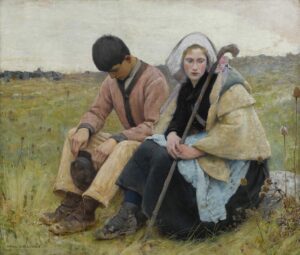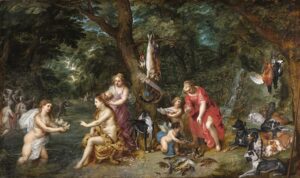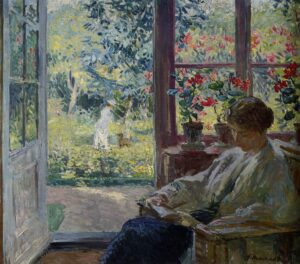Naturalism in art is a style that strives to depict subjects as accurately as possible without artificiality.
It’s a true-to-life approach that’s about capturing the world with a keen eye for detail.
We’ll explore how naturalism evolved and its impact on various art forms.
From paintings to sculptures, we’ll jump into why this movement has captivated artists and audiences alike for centuries.
The Origins Of Naturalism In Art
Naturalism’s roots are deeply embedded in the artistic soil of the Renaissance.
During the 14th century, European artists like Giotto began shifting away from the idealized figures that dominated the medieval period, striving instead for a more realistic portrayal of the human form and the natural world.
In the late 18th and early 19th centuries, naturalism found new ground to flourish.
The movement gained momentum alongside the rise of scientific interest and the Enlightenment’s emphasis on empiricism and rationality.
Artists were no longer just creators but observers, meticulously studying their subjects to capture the world as it was.
Among the notable artists who pioneered the naturalist ethic was Gustave Courbet, whose commitment to depicting the unembellished truth paved the way for modern realist thought.
His masterpiece The Stone Breakers reflected a profound social consciousness and an unflinching representation of laborers’ everyday life.
Naturalism also branched into other art forms:
- In literature, novelists like Émile Zola employed naturalistic elements to explore the human condition through characters shaped by their environment and heredity.
- Theatre followed with playwrights such as Henrik Ibsen, who introduced a naturalistic style in their productions, effectively transforming the stage into a mirror of real life.
While often intertwined with realism, naturalism stands distinct in its scientific underpinnings and deterministic philosophy.
Artists and creators within this movement sought not just to show life but to unveil the underlying truths governed by nature’s laws.
Characteristics Of Naturalism
Reflecting on our extensive experience in the realm of art, we’ve come to recognize the distinct characteristics that define naturalism.
This movement is an expressive force, hinged on meticulous accuracy and a profound pursuit of realism.
- True-to-life representation – Naturalist art mirrors the real world with precision. Artists employ careful observation to capture every detail authentically.
- Attention to detail – The minutiae in a naturalist painting or scene in a film are painstakingly depicted, from the texture of skin to the subtleties of light.
Naturalism forges a path that connects art to the scientific methodology of its era.
Each brushstroke in a canvas or scene crafted on screen is governed by a relentless commitment to depict life, as it is, unadorned by romantic idealization.
Artists inspired by naturalism are no strangers to exploring the darker and more complex aspects of life.
Rather than shying away from the grittier parts of existence, naturalism lays them bare for the viewer to contemplate.
- Subjects from everyday life – Ordinary people and daily scenarios become the central themes, eschewing the glorification of mythological or historical subjects.
- Use of light and shadow – The interplay of chiaroscuro is meticulously rendered, emphasizing form and depth within the composition.
Deeply intertwined with literature and theater, naturalism in film builds on these foundational artistic principles.
Filmmakers, like our colleagues who craft narratives behind the lens, use naturalistic elements to weave authenticity into the visual storytelling.
- Character-driven narratives – Stories focus on the complexity of characters, often highlighting social issues or naturalistic determinism.
It’s through this lens that scenes become immersive experiences, inviting audiences to step into a world mirroring their own.
Our collective understanding of naturalism in art not only enriches our appreciation but illuminates its enduring impact across various mediums.
Naturalism In Painting
When we jump into the realm of naturalism in painting, we’re swept into a world where artists wield their brushes to capture life in its rawest form.
Painters like Jean-François Millet and Gustave Courbet were pioneers of this movement, choosing to forsake the romantic dramatization of subjects for a more candid portrayal.
Their canvases offer not just visuals but narratives steeped in the realities of their time.
The unfettered representation of subject matter is what sets apart naturalistic paintings.
The stark play of light and shadow in The Gleaners by Millet does more than just depict peasant women collecting leftover grain; it speaks to the socio-economic conditions of the period.
Similarly, Courbet’s The Stone Breakers unwaveringly presents the grueling labor of workers, eschewing any embellishments or heroic undertones.
Artists committed to naturalism often centered their work around:
- Ordinary people and daily life scenes,
- Nature and rural landscapes,
- Social issues and the working class.
In these works, the brushwork remains subtle, ensuring that attention is not diverted from the subject to the artistic technique.
The use of color adheres to what’s seen by the naked eye, reinforcing naturalism’s devotion to authenticity.
In film, this translates to techniques that eschew artificial lighting and set pieces in favor of location shooting and natural light, drawing the viewer into an unfiltered experience of the narrative.
Naturalism In Sculpture
Moving from the realm of painting to the three-dimensional world of sculpture, we find that naturalism played a significant role here as well.
Sculptors in the Naturalist movement endowed their creations with a powerful sense of realism that echoed the same principles seen in the naturalistic paintings of Millet and Courbet.
Much like their counterparts with brush and canvas, these artists focused on ordinary people, portraying the human figure not stylized or idealized, but as it truly appeared.
One of the most compelling examples of naturalism in sculpture is the work of Auguste Rodin.
Known for his keen observation and ability to capture human expression, Rodin’s pieces such as The Age of Bronze and The Burghers of Calais demonstrate an unparalleled fidelity to the natural world.
His sculptures showcase:
- The intricacy of human anatomy,
- The psychological depth of the subjects,
- The impact of natural light on form.
Naturalistic sculpture often extends beyond the aesthetic to engender a profound connection with its viewers.
These works provoke thought and encourage empathy by exemplifying the genuine struggles and emotions experienced by the subject.
The skilled manipulation of materials such as bronze, marble, or wood further enhances the tactile reality of these pieces – inviting us not only to look but to feel the essence of the subjects portrayed.
Within the broader scope of naturalism, it’s essential to recognize the diversity of mediums and the shared commitment to representing life authentically.
Whether we’re discussing the raw beauty captured on canvas or the palpable emotions immortalized in stone, our exploration of naturalistic art continues to reveal the depths of human experience as seen through the eyes of artists who dared to highlight the truth of their times.
The Impact Of Naturalism On Art Movements
Naturalism has had a profound influence on various art movements, continually pushing the boundaries of artistic expression.
As we jump into the ways in which naturalism impacted these movements, it’s apparent that its principles permeated many aspects of art, shaping the course of history in the arts.
Realism was born directly from the womb of Naturalism, as artists sought to depict the world without the romanticization or drama that was common in earlier movements.
Realism represented ordinary subjects with truth and accuracy, focusing on everyday life scenes that were relatable to the viewers.
Notable artists like Gustave Courbet and Jean-François Millet pioneered this movement, setting a foundation that would influence countless others.
Following Realism, Impressionism emerged with a unique take on naturalism.
Artists like Claude Monet and Edgar Degas began interpreting the world through a subjective lens – capturing fleeting moments of natural light and color in their works.
Their dedication to painting ‘en plein air’ allowed them to capture the transient effects of sunlight and atmosphere, further broadening the scope of naturalistic influence in art.
The ripples of naturalism extended beyond the brushstrokes of paint and into the frames of film, impacting the development of Cinéma Vérité within filmmaking.
Directors adopted a naturalistic approach by using real-life scenarios, non-professional actors, and handheld cameras.
This style strived for authenticity and the unvarnished truth, similarly mirroring the goals of naturalist painters.
Each of these movements shared a common goal – to present life with sincerity and genuine emotion:

- Realism paved the way with its honest portrayals of societal conditions.
- Impressionism captured the impermanent beauty of life.
- Cinéma Vérité laid bare the unscripted reality of the human experience.
The thread of naturalism weaves through numerous other movements, including Modernism and Contemporary Art, always encouraging artists to reflect upon and respond to their lived realities through their work.
As we continue to explore the diverse expressions of naturalism in art, it’s clear that its humanitarian philosophy deeply resonates across various disciplines and will likely continue to do so for generations to come.
Naturalism In Contemporary Art
Naturalism has found its way into contemporary art, reflecting the ever-evolving relationship between society and the environment.
Artists today often channel a naturalistic approach to raise awareness about pressing issues or to explore the human condition in its raw form.
Take, for example, the large-scale installations by Olafur Eliasson that recreate elements of the natural world, challenging viewers to ponder their interaction and connection with their surroundings.
With the advance of technology, digital artists are also embracing naturalistic themes, blending the traditional with the modern.

Pieces like The Treachery of Sanctuary by Chris Milk Use interactive technology to immerse the audience in bird-like experiences, blurring the line between the observer and the natural world.

This merger of tech and natural elements exemplifies the progressive interpretation of naturalism in contemporary artistic practices.
In the realm of film, Cinéma Vérité continues to influence documentary filmmaking where the approach is not just a style but a philosophy.
By capturing events as they unfold, films such as The Act of Killing and Citizenfour present real-world issues in an unadulterated format, compelling the audience to face the authenticity head-on.
Here, the essence of naturalism is not merely aesthetic; it’s deeply rooted in ethical and existential queries about our existence and the structures that govern it.
Turning to photography, the influence of naturalism can be seen permeating through photojournalism and landscape photography:
- Portraits that convey the unfiltered emotions of their subjects,
- Landscape shots that showcase the breathtaking beauty without digital enhancement.
This steadfast commitment to depicting reality as it is continues to inform and inspire our approach to filmmaking and content creation.
Our visuals not only capture moments but also tell stories that resonate with the genuineness and spontaneity that naturalism in contemporary art champions.
What Is Naturalism In Art – Wrap Up
We’ve seen how naturalism has woven its threads through the fabric of art history, shaping movements and inspiring artists to capture the essence of their environments.
It’s a testament to the enduring quest for authenticity in artistic expression.
From the unembellished truth of Realism to the subjective vibrancy of Impressionism, naturalism’s influence is undeniable.
In today’s art scene, it continues to challenge and engage us, pushing the boundaries of how we interact with the world around us.
Whether through the lens of a camera or the brush on a canvas, the spirit of naturalism lives on, urging us to see the genuine beauty in the everyday.
Frequently Asked Questions
What Is Naturalism In Art?
Naturalism in art is a style that aims to depict subjects as accurately and truthfully as possible, without artificiality or exaggeration.
How Did Naturalism Influence Realism?
Naturalism influenced Realism by encouraging artists to depict ordinary subjects with truth and accuracy, focusing on the real world without romanticization.
What Is Impressionism And How Is It Related To Naturalism?
Impressionism is an art movement that interpreted the world through a subjective lens, often focusing on the effects of natural light and color.
It is related to Naturalism in its attempt to capture authentic moments and environments.
What Is Cinéma Vérité And How Does It Connect To Naturalism?
Cinéma Vérité is a filmmaking style that incorporates naturalistic methods to portray real life with authenticity and unvarnished truth, aligning with Naturalism’s emphasis on genuine representation.
How Has Naturalism Impacted Modernism And Contemporary Art?
Naturalism has inspired Modernism and Contemporary Art to reflect lived realities, with a focus on genuineness and spontaneity, seen in large-scale installations and digital art that merge traditional and modern elements.
In What Ways Is Naturalism Present In Contemporary Digital Art?
In contemporary digital art, Naturalism is present through the merger of traditional themes and modern techniques, expressing genuine emotions and often emphasizing a connection with the environment.
How Does Naturalism Influence Current Documentary Filmmaking And Photojournalism?
Naturalism influences documentary filmmaking and photojournalism by encouraging a raw and unadulterated portrayal of real-world issues and environments, often avoiding digital enhancement to preserve authenticity.


